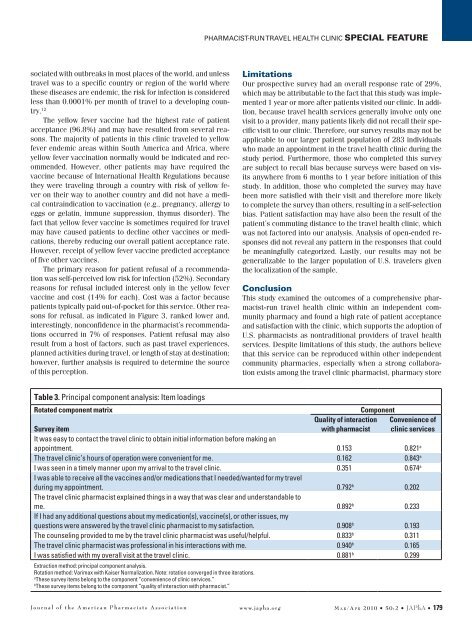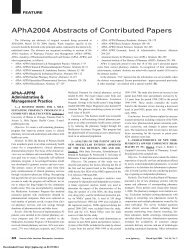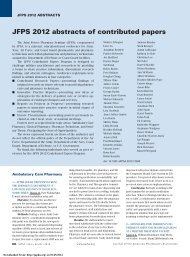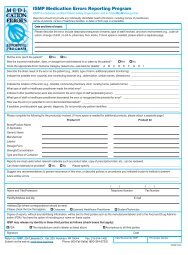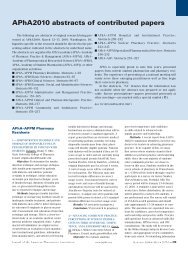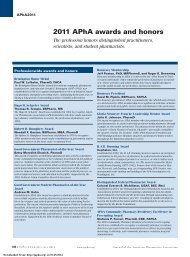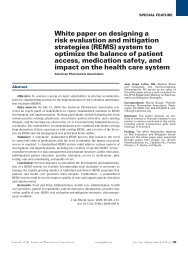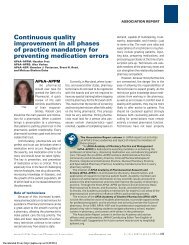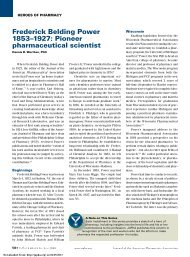Measuring outcomes of a pharmacist-run travel health clinic located ...
Measuring outcomes of a pharmacist-run travel health clinic located ...
Measuring outcomes of a pharmacist-run travel health clinic located ...
Create successful ePaper yourself
Turn your PDF publications into a flip-book with our unique Google optimized e-Paper software.
sociated with outbreaks in most places <strong>of</strong> the world, and unless<br />
<strong>travel</strong> was to a specific country or region <strong>of</strong> the world where<br />
these diseases are endemic, the risk for infection is considered<br />
less than 0.0001% per month <strong>of</strong> <strong>travel</strong> to a developing country.<br />
12<br />
The yellow fever vaccine had the highest rate <strong>of</strong> patient<br />
acceptance (96.8%) and may have resulted from several reasons.<br />
The majority <strong>of</strong> patients in this <strong>clinic</strong> <strong>travel</strong>ed to yellow<br />
fever endemic areas within South America and Africa, where<br />
yellow fever vaccination normally would be indicated and recommended.<br />
However, other patients may have required the<br />
vaccine because <strong>of</strong> International Health Regulations because<br />
they were <strong>travel</strong>ing through a country with risk <strong>of</strong> yellow fever<br />
on their way to another country and did not have a medical<br />
contraindication to vaccination (e.g., pregnancy, allergy to<br />
eggs or gelatin, immune suppression, thymus disorder). The<br />
fact that yellow fever vaccine is sometimes required for <strong>travel</strong><br />
may have caused patients to decline other vaccines or medications,<br />
thereby reducing our overall patient acceptance rate.<br />
However, receipt <strong>of</strong> yellow fever vaccine predicted acceptance<br />
<strong>of</strong> five other vaccines.<br />
The primary reason for patient refusal <strong>of</strong> a recommendation<br />
was self-perceived low risk for infection (52%). Secondary<br />
reasons for refusal included interest only in the yellow fever<br />
vaccine and cost (14% for each). Cost was a factor because<br />
patients typically paid out-<strong>of</strong>-pocket for this service. Other reasons<br />
for refusal, as indicated in Figure 3, ranked lower and,<br />
interestingly, nonconfidence in the <strong>pharmacist</strong>’s recommendations<br />
occurred in 7% <strong>of</strong> responses. Patient refusal may also<br />
result from a host <strong>of</strong> factors, such as past <strong>travel</strong> experiences,<br />
planned activities during <strong>travel</strong>, or length <strong>of</strong> stay at destination;<br />
however, further analysis is required to determine the source<br />
<strong>of</strong> this perception.<br />
PHARMACIST-RUn TRAvEL HEALTH CLInIC SPECIAL FEATURE<br />
Limitations<br />
Our prospective survey had an overall response rate <strong>of</strong> 29%,<br />
which may be attributable to the fact that this study was implemented<br />
1 year or more after patients visited our <strong>clinic</strong>. In addition,<br />
because <strong>travel</strong> <strong>health</strong> services generally involve only one<br />
visit to a provider, many patients likely did not recall their specific<br />
visit to our <strong>clinic</strong>. Therefore, our survey results may not be<br />
applicable to our larger patient population <strong>of</strong> 283 individuals<br />
who made an appointment in the <strong>travel</strong> <strong>health</strong> <strong>clinic</strong> during the<br />
study period. Furthermore, those who completed this survey<br />
are subject to recall bias because surveys were based on visits<br />
anywhere from 6 months to 1 year before initiation <strong>of</strong> this<br />
study. In addition, those who completed the survey may have<br />
been more satisfied with their visit and therefore more likely<br />
to complete the survey than others, resulting in a self-selection<br />
bias. Patient satisfaction may have also been the result <strong>of</strong> the<br />
patient’s commuting distance to the <strong>travel</strong> <strong>health</strong> <strong>clinic</strong>, which<br />
was not factored into our analysis. Analysis <strong>of</strong> open-ended responses<br />
did not reveal any pattern in the responses that could<br />
be meaningfully categorized. Lastly, our results may not be<br />
generalizable to the larger population <strong>of</strong> U.S. <strong>travel</strong>ers given<br />
the localization <strong>of</strong> the sample.<br />
Conclusion<br />
This study examined the <strong>outcomes</strong> <strong>of</strong> a comprehensive <strong>pharmacist</strong>-<strong>run</strong><br />
<strong>travel</strong> <strong>health</strong> <strong>clinic</strong> within an independent community<br />
pharmacy and found a high rate <strong>of</strong> patient acceptance<br />
and satisfaction with the <strong>clinic</strong>, which supports the adoption <strong>of</strong><br />
U.S. <strong>pharmacist</strong>s as nontraditional providers <strong>of</strong> <strong>travel</strong> <strong>health</strong><br />
services. Despite limitations <strong>of</strong> this study, the authors believe<br />
that this service can be reproduced within other independent<br />
community pharmacies, especially when a strong collaboration<br />
exists among the <strong>travel</strong> <strong>clinic</strong> <strong>pharmacist</strong>, pharmacy store<br />
Table 3. Principal component analysis: Item loadings<br />
Rotated component matrix Component<br />
Quality <strong>of</strong> interaction Convenience <strong>of</strong><br />
Survey item<br />
It was easy to contact the <strong>travel</strong> <strong>clinic</strong> to obtain initial information before making an<br />
with <strong>pharmacist</strong> <strong>clinic</strong> services<br />
appointment. 0.153 0.821a The <strong>travel</strong> <strong>clinic</strong>’s hours <strong>of</strong> operation were convenient for me. 0.162 0.843a I was seen in a timely manner upon my arrival to the <strong>travel</strong> <strong>clinic</strong>. 0.351 0.674a I was able to receive all the vaccines and/or medications that I needed/wanted for my <strong>travel</strong><br />
during my appointment. 0.792b The <strong>travel</strong> <strong>clinic</strong> <strong>pharmacist</strong> explained things in a way that was clear and understandable to<br />
0.202<br />
me. 0.892b If I had any additional questions about my medication(s), vaccine(s), or other issues, my<br />
0.233<br />
questions were answered by the <strong>travel</strong> <strong>clinic</strong> <strong>pharmacist</strong> to my satisfaction. 0.908b 0.193<br />
The counseling provided to me by the <strong>travel</strong> <strong>clinic</strong> <strong>pharmacist</strong> was useful/helpful. 0.833b 0.311<br />
The <strong>travel</strong> <strong>clinic</strong> <strong>pharmacist</strong> was pr<strong>of</strong>essional in his interactions with me. 0.940b 0.165<br />
I was satisfied with my overall visit at the <strong>travel</strong> <strong>clinic</strong>. 0.881b Extraction method: principal component analysis.<br />
Rotation method: Varimax with Kaiser Normalization. Note: rotation converged in three iterations.<br />
aThese survey items belong to the component “convenience <strong>of</strong> <strong>clinic</strong> services.”<br />
bThese survey items belong to the component “quality <strong>of</strong> interaction with <strong>pharmacist</strong>.”<br />
0.299<br />
J o u r n a l o f t h e A m e r i c a n P h a r m a c i s t s A s s o c i a t i o n www.japha.org M a r/apr 2010 • 50:2 • JAPhA • 179<br />
179 3/1/10 12:49 PM


